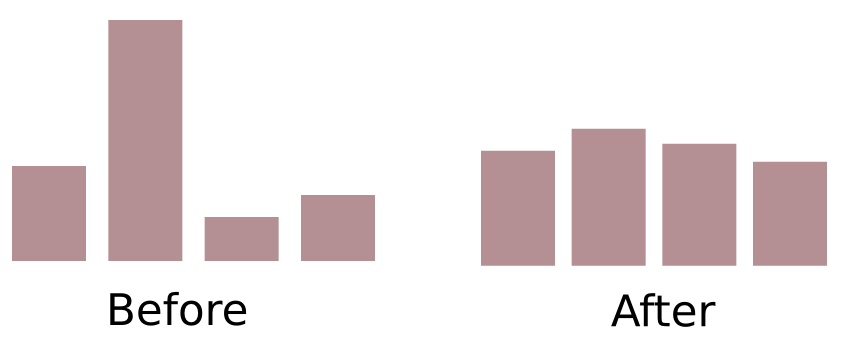One possibility is to use Cramer's v adapted for use in chi-square goodness of fit tests.
A variant of Cramer's v is described in Wikipedia. It takes the chi-square value from a chi-square goodness-of-fit test and divides it by the product of the total observations and the number of categories minus one, and takes the square root of this value.
In your case you can think about expected frequencies for the chi-square test to be equally divided among categories.
In this case, Cramer's v will be equal to 1 when all the observations fall in one category, and will be equal to 0 when the observations are equally divided among categories. Cramer's v is not affected by sample size.
So, in your case, the larger Cramer's v, the more unevenly distributed the categories.
An example in R.
Before = c(6, 15, 4, 5)
Before.expected = c(0.25, 0.25, 0.25, 0.25)
X2Before = chisq.test(x = Before,
p = Before.expected)
X2Before
### Chi-squared test for given probabilities
### data: Before
### X-squared = 10.267, df = 3, p-value = 0.01643
X2 = X2Before$statistic
N = sum(Before)
K = length(Before)
CramerV = sqrt(X2 / (N*(K-1)))
names(CramerV) = "Cramer's V"
CramerV
### Cramer's V
### 0.3377485
# # #
After = c(7, 9, 7, 7)
After.expected = c(0.25, 0.25, 0.25, 0.25)
X2After = chisq.test(x = After,
p = After.expected)
X2After
X2 = X2After$statistic
### Chi-squared test for given probabilities
### data: After
### X-squared = 0.4, df = 3, p-value = 0.9402
N = sum(After)
K = length(After)
CramerV = sqrt(X2 / (N*(K-1)))
names(CramerV) = "Cramer's V"
CramerV
### Cramer's V
### 0.06666667
I added a function to my rcompanion package for Cramér's V for situations like chi-square goodness-of-fit.
if(!require(rcompanion)){install.packages("rcompanion")}
library(rcompanion)
Before = c(6, 15, 4, 5)
### Cramer V
### 0.3377
cramerVFit(Before)
After = c(7, 9, 7, 7)
cramerVFit(After)
### Cramer V
### 0.06667

